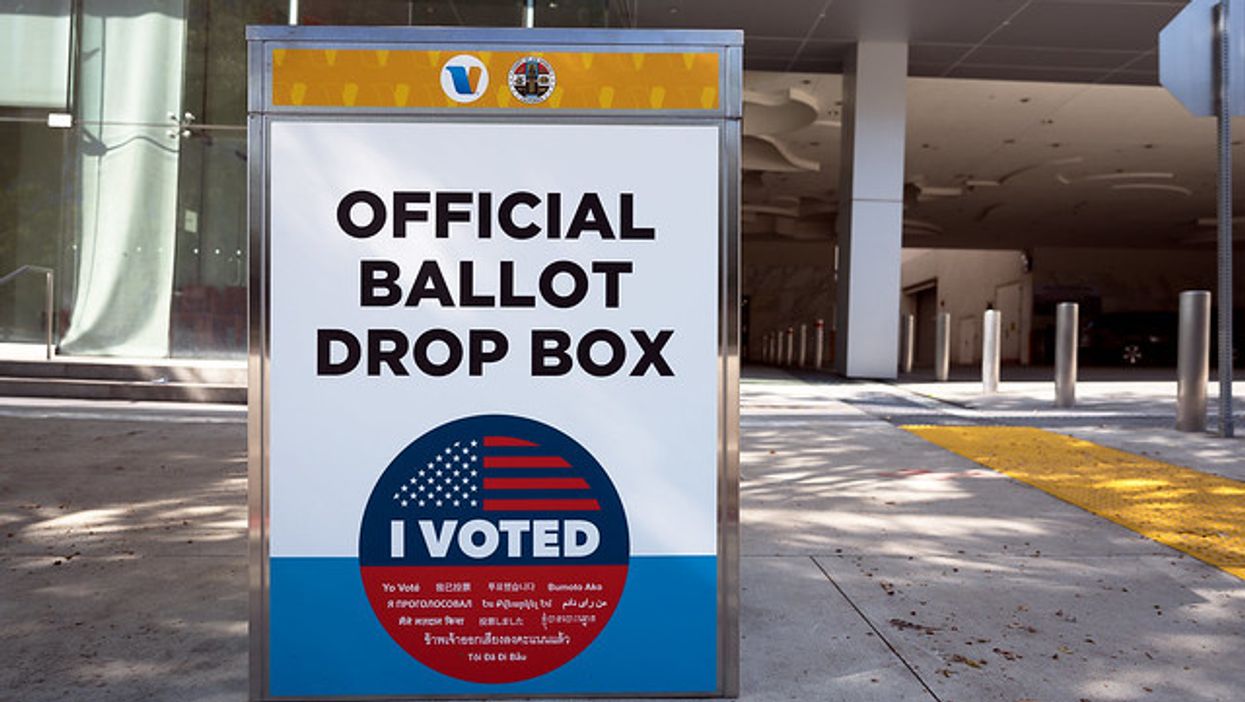Prompted By Trump Attacks? Vandals Set Fire To Ballot Boxes
A ballot drop box outside the Boston Public Library was set ablaze last Sunday, marking the second such instance in just over a week after another ballot drop box was burned outside a California library on October 18.
The two incidents come as Donald Trump eagerly pushes debunked claims of fraud regarding mail-in ballots.
The suspected arson attempt destroyed 35 ballots out of the 122 in the box at the time of the fire, according to the Boston Election Department.
"What happened in the early hours of this morning to the ballot drop box in Copley Square is a disgrace to democracy, a disrespect to the voters fulfilling their civic duty, and a crime," Massachusetts Secretary of State William Galvin and Boston Mayor Martin Walsh said in a joint statement.
Last Sunday, a vote-by-mail drop box outside of the Baldwin Park Library, east of Los Angeles County in California, was also set on fire in another suspected arson attempt. A burning newspaper was purposely thrown into the box, according to firefighters.
Manuel Lozano, mayor of Baldwin Park, said he believes around 100 ballots were damaged.
"People are frustrated across the country, it's no different in Baldwin Park," the mayor said.
He added that the incident "send[s] a very bad message ... the frustration with the voting box and then this occurs."
Los Angeles County Supervisor Janice Hahn called the attack on the ballot drop box "reprehensible."
"Burning ballots is not just vandalism, it is an attack on our democracy and on our residents' right to vote. Whoever did this must be found and prosecuted to the fullest extent of the law," she said in a statement.
The incidents come amid Trump's continued unfounded claims about mail-in ballot fraud, claims which have been thoroughly and repeatedly debunked.
"Some states use 'drop boxes' for the collection of Universal Mail-In Ballots. So who is going to 'collect' the Ballots, and what might be done to them prior to tabulation? A Rigged Election?" he tweeted in August.
Days later, he tweeted: "So now the Democrats are using Mail Drop Boxes, which are a voter security disaster. Among other things, they make it possible for a person to vote multiple times. Also, who controls them, are they placed in Republican or Democrat areas? They are not Covid sanitized. A big fraud!"
Twitter labeled Trump's tweet as violating the platform's rules on "civic and election integrity."
Election experts including Wendy Weiser, the director of the Democracy Program at the Brennan Center, told CNN that election administrators abide by the same security practices as all other ballots collected.
"The bottom line is that absentee and mail balloting are secure in America," she said.
Election administrators who handle cast ballots in polling places are the only ones who have access to the ones in ballot drop boxes, said Weiser. Poll workers also process ballots in the same manner before tabulation.
Amber McReynolds, CEO of the nonprofit National Vote at Home Institute, does not believe fraud is a major problem with mail-in balloting.
"The system with things like signature verification helps to detect and prevent fraud," she told the American Independent Foundation in an email.
The federal Elections Assistance Commission has issued a number of security considerations for ballot drop boxes, to prevent fraud.
"Ballot drop boxes must be secured and locked at all times. Only an election official or a designated ballot drop box collection team should have access to the keys and/or combination of the lock. In addition to locks, all drop boxes should be sealed with one or more tamper-evident seals," it wrote.
Joe Ready, director of U.S. Public Interest Research Group's (PIRG) Democracy for the People Campaign, warned in a recent opinion column for MarketWatch that Americans should not "be distracted by Trump's Twitter rants or his administration's frivolous, unwinnable lawsuits."
"Ballot drop boxes are a smart, socially distanced and secure way to give you a safe option to cast your ballot," he wrote. "When using a drop box, you can be confident that your vote will be counted and your voice will be heard."
Meanwhile, lawmakers are tightening the security of ballot drop boxes even further.
"In light of this incident, I am asking that the Registrar Recorder ensure ballot boxes are emptied nightly from now until Election Day," Hahn said.
Boston City Councilor Ed Flynn, who called this week's arson attempt "a threat to our democracy," "a shameful act and crime," said that he is "beefing up security" measures as well.
"We need to ensure the integrity of our elections process, and should have additional security measures at ballot box and polling locations to make sure all ballots are protected and counted," he said.
Published with permission of The American Independent Foundation.












